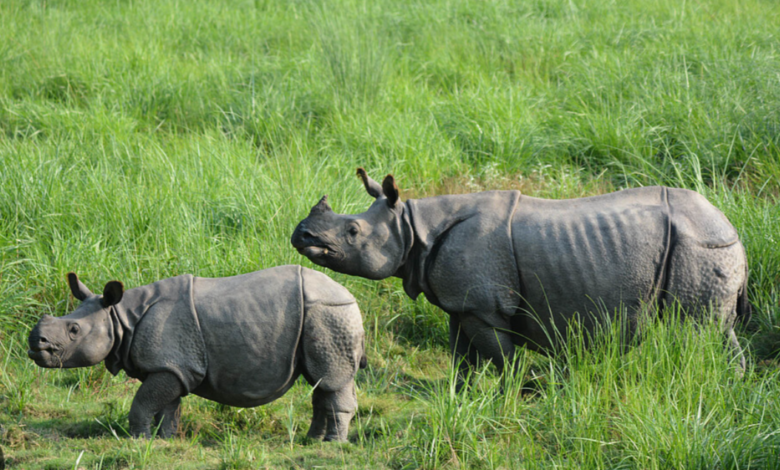Assam’s rhino population rises five-times, reaching 3,000 from 600 since 2016
Kaziranga National Park and Tiger Reserve is home to 80 per cent of India’s rhino population, while Orang National Park hosts 4 percent.

Assam has seen a remarkable rise in its rhino population over the past sixty years, growing from approximately 600 in the 1960s to over 3,000 today. The Assam government shared this data on World Rhino Day, highlighting the state’s successful conservation efforts to boost the rhino population. Despite this growth, the species remains classified as ‘vulnerable’ on the IUCN Red List.
Kaziranga National Park and Tiger Reserve is home to 80 per cent of India’s rhino population, while Orang National Park hosts 4 per cent, Pobitora Wildlife Sanctuary 3 per cent, and Manas National Park 1 percent.
Apart from Assam, Jaldapara National Park and Gorumara National Park in West Bengal hold 9 per cent and 2 percent of the country’s total rhino population, respectively. Dudhwa National Park in Uttar Pradesh contributes another 1 per cent to India’s rhino population.

Global Decline in Rhino Population: Assam’s Success Story Offers Hope
The exceptional increase in the rhino population was attributed to the government’s successful conservation efforts, said Assam Chief Minister Himanta Biswa Sarma.
A post shared by the CM states, “Rhinos are integral to Assam’s identity, representing our pride and serving as the crown jewel of our biodiversity. Since assuming office, we have implemented numerous initiatives aimed at protecting and expanding their habitats.”
The Chief Minister highlighted the government’s efforts in rhino conservation, focusing on habitat expansion and restoration across several regions. He stated that 200.7 sq km had been added to Orang National Park and 195 sq km to Burachapori Wildlife Sanctuary. Furthermore, 12.8 sq km of rhino habitat in the Laokhowa-Burachapori complex had been restored and cleared of encroachments, paving the way for rhinos to return to the area.
Another factor highlighted by Sharma was the significant decline in poaching, with a reduction of 86 per cent since the government took office in 2016. The combined efforts between the state government and local communities have greatly contributed to the protection of Assam’s rhinos.
India’s one-horned Asian rhinoceros population has experienced a significant recovery over the past four decades, increasing from 1,500 to over 4,000, thanks to dedicated conservation and anti-poaching measures. Back in the 1960s, the population had dwindled to a mere 600, putting the species at severe risk. A key factor in this resurgence has been the collaborative efforts of India’s forest department, which implemented stricter protection laws, and local communities, who actively participated in conservation initiatives. The establishment of protected areas and rhino corridors, habitat restoration, and the use of modern technology like drones for surveillance have also contributed to this remarkable comeback.
Rhinos, living for around 50 years and weigh around 2,800 kilograms. They are primarily found in the grasslands, swamps, and riverine forests of eastern India and Nepal. They weigh around 2,800 kilograms and Globally, their population has plummeted from 500,000 in the early 1900s to approximately 28,000 today.
You might also be interested in – 22-year-old entrepreneur from Assam accused of Rs 2,200 crore financial scam



